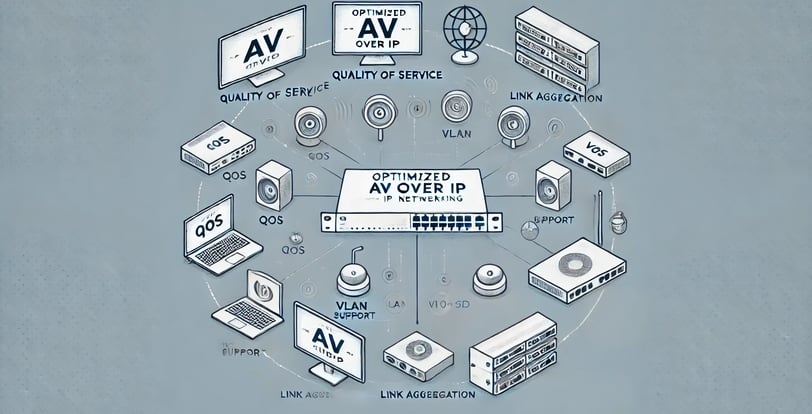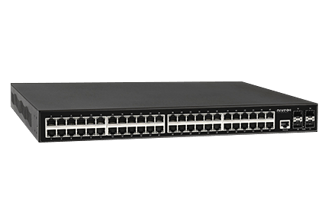Optimizing AV Over IP: Tips for Success
#AVCentricNetworking #Avixa, #Cedia, #AVNU, #SDVoE #AVoIP #AVoverIP #proav #AVTweeps
Arthur de Jager - Niveo Professional
10/17/20244 min read


Optimizing AV Over IP: Tips for Success
Introduction
Audio-Visual over Internet Protocol (AV over IP) is rapidly becoming the standard for distributing audio and video signals in various professional environments. By leveraging existing network infrastructure, AV over IP offers unparalleled flexibility, scalability, and cost-effectiveness compared to traditional AV systems. However, to fully harness these benefits, it’s essential to optimize AV over IP systems to ensure high performance, low latency, and reliable operation. This blog provides valuable tips for optimizing AV over IP installations and highlights how Niveo Professional contributes to successful implementations.
Understanding AV Over IP
AV over IP refers to the transmission of audio and video data over standard network infrastructure using Internet Protocol (IP). This approach contrasts with traditional AV systems that rely on dedicated point-to-point cabling. The key advantages of AV over IP include:
Scalability: Easily expand the system by adding more devices without extensive rewiring.
Flexibility: Devices can be located anywhere on the network, providing greater flexibility in design and deployment.
Cost-Effectiveness: Utilize existing network infrastructure, reducing the need for specialized cabling and hardware.
Centralized Management: Manage and control all AV devices from a central location, simplifying operations and maintenance.
Tips for Optimizing AV Over IP
1. Ensure Sufficient Bandwidth
One of the most critical factors in optimizing AV over IP systems is ensuring that the network has sufficient bandwidth to handle high-quality audio and video streams. Insufficient bandwidth can lead to latency, jitter, and packet loss, degrading the AV experience.
Assess Bandwidth Needs: Calculate the total bandwidth requirements based on the number and resolution of video streams, as well as the audio channels being transmitted.
Use High-Speed Ethernet: Deploy Gigabit or higher-speed Ethernet connections to ensure ample bandwidth for AV data.
Implement VLANs: Segment AV traffic using Virtual Local Area Networks (VLANs) to isolate it from other network traffic and reduce congestion.
2. Prioritize Traffic with Quality of Service (QoS)
Quality of Service (QoS) is essential for ensuring that AV traffic is prioritized over less critical data. By configuring QoS settings on network switches, you can minimize latency and ensure smooth transmission of audio and video signals.
Set Traffic Priorities: Assign higher priority to AV traffic compared to other types of data, such as file transfers or web browsing.
Configure QoS Policies: Use QoS policies to manage bandwidth allocation and prevent network congestion.
3. Optimize Network Infrastructure
Optimizing the network infrastructure is crucial for achieving high performance and reliability in AV over IP systems.
Use Managed Switches: Managed switches offer advanced features such as QoS, VLANs, and link aggregation, providing better control and optimization of network traffic.
Employ Link Aggregation: Combine multiple network connections to increase bandwidth and provide redundancy, ensuring continuous operation even if one link fails.
Deploy Fiber Optic Cables: For long-distance data transmission, fiber optic cables offer higher bandwidth and lower latency compared to copper cables.
4. Minimize Latency and Jitter
Low latency and minimal jitter are essential for maintaining synchronization and delivering a high-quality AV experience.
Choose Low-Latency Codecs: Use codecs designed for low-latency performance to minimize the delay in audio and video transmission.
Optimize Network Paths: Ensure that network paths are as direct as possible, reducing the number of hops and potential points of delay.
Monitor Network Performance: Regularly monitor network performance to identify and address sources of latency and jitter.
5. Implement Redundancy and Failover Mechanisms
To ensure continuous operation and prevent downtime, implement redundancy and failover mechanisms in your AV over IP system.
Redundant Links: Use multiple network links to provide backup in case of a primary link failure.
Failover Protocols: Implement failover protocols to automatically switch to backup systems if a primary component fails.
Power Redundancy: Use uninterruptible power supplies (UPS) and redundant power sources to keep critical network components operational during power outages.
6. Secure the Network
Security is a critical consideration in AV over IP systems to protect against unauthorized access and cyber threats.
Use Encryption: Encrypt AV data to protect it from interception and tampering during transmission.
Implement Access Controls: Use strong authentication and access control mechanisms to restrict access to AV devices and network resources.
Regularly Update Firmware: Keep all network devices and software up to date with the latest security patches and firmware updates.
7. Leverage Centralized Management and Monitoring Tools
Centralized management and monitoring tools simplify the operation and maintenance of AV over IP systems, providing real-time insights and control over network performance.
Network Management Software: Use network management software to monitor network performance, configure devices, and troubleshoot issues remotely.
Automated Alerts: Set up automated alerts to notify administrators of potential issues, allowing for prompt intervention and resolution.
The Role of Niveo Professional in Optimizing AV Over IP
Niveo Professional is at the forefront of providing high-performance networking solutions designed to optimize AV over IP systems. Their advanced switches and networking equipment are equipped with features such as QoS, VLAN support, link aggregation, and robust security protocols. These features ensure that AV traffic is prioritized, bandwidth is efficiently managed, and the network remains secure and reliable.
Moreover, Niveo Professional's commitment to innovation and quality means that their products are built to support the demands of modern AV over IP installations. With user-friendly management tools and automated configuration options, Niveo Professional makes it easier for integrators to deploy and maintain optimized AV networks, ensuring high performance and exceptional user experiences.
In conclusion, optimizing AV over IP systems involves ensuring sufficient bandwidth, prioritizing traffic, minimizing latency, and implementing robust security measures. By leveraging advanced networking features and centralized management tools, integrators can achieve high performance and reliability in their AV installations. Niveo Professional's high-performance networking solutions play a crucial role in this process, providing the tools and capabilities needed to optimize AV over IP systems for success.
About Niveo Professional
Niveo Professional is a leading manufacturer of Network Equipment for pro-AV. A pioneer in the industry, that has brought many innovations to make life of the Integrator Easy!
About Arthur de Jager
Arthur de Jager is co-founder of Niveo Professional, Entrepreneur and author and active in the AV-industry for over 30 Years.






